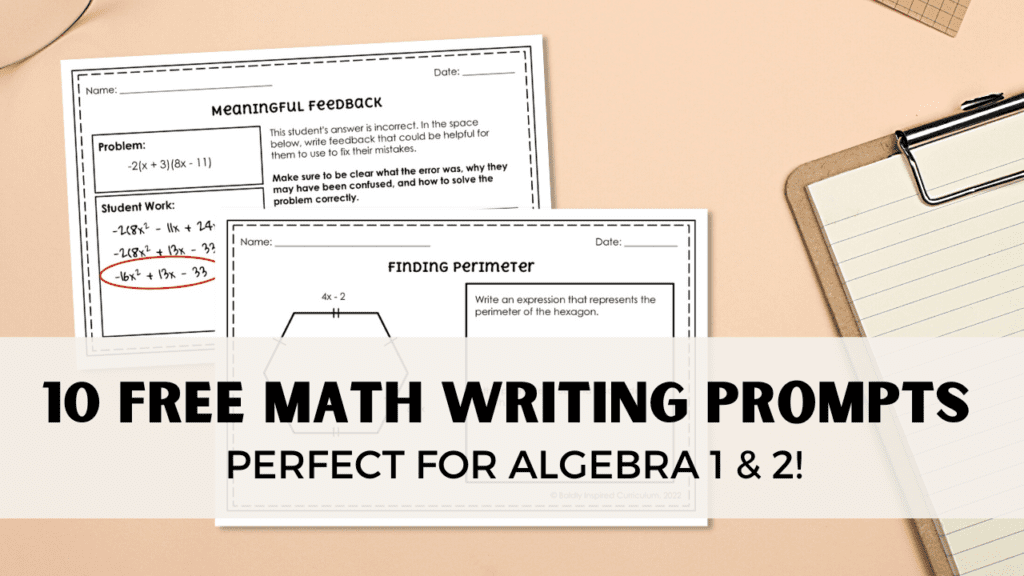Have you asked your students any open ended questions in math class this week?
And I don’t mean a question that has more than just a yes or no answer. I’m talking about a question that could have more than one answer.
One of my main goals as a math teacher is to help my students think beyond just how to solve a problem. I want them to analyze, make predictions, and really just start writing down their thoughts.
I started assigning my students writing prompts to see what they had to say. Writing prompts are a quick way to get an idea of what your students understand or introduce them to a topic. Remember: adding writing to math doesn’t have to be complicated!
Here’s what happened when I started asking open ended questions in my math classroom ↓
Students want their opinions to be heard (but not always loudly for the shy kids in your class). Giving them opportunities to share their thinking can make them feel like the work they are doing is important.
Don’t get me wrong…your students might not love it at first. Isn’t that how everything goes though? I know that when I try something new and I’m not immediately good at it, then I’ll get frustrated and want to give up. (I’m working on getting better at this!)
The same can be said for many of your students. It might be ugly at first. But, the more you can practice writing skills with your students the better they will become.
Even your most resistant students may start to like it! You’ll never know until you try, right?
Warm Ups
Start off your class period with reflective, open ended questions that lead into a discussion or a turn and talk with partners. Writing prompts can get students thinking in different ways about a concept and sharing those thoughts on paper.
You can start simple at first by giving your students non-math related questions to get them into the habit of writing. Eventually, you’ll be able to increase the difficulty of the questions until they are critical thinking masters!
The most important part of using the critical thinking questions is making sure your students have the confidence to write down their thoughts (even if they aren’t correct!).
Exit Tickets
Writing prompts are perfect for having students reflect on a lesson or making further connections. These exit tickets could be error analysis problems, word problems, or standard journal prompts.
Small Group
Give one (or multiple!) prompts to your students in small groups to discuss and work through together. This is a great opportunity for your students to work on application problems and rely on each other for support rather than you.
They’ll be developing their communication and collaboration skills right before your eyes!
Task Cards
There are multiple ways to use task cards in your classroom that are different from the typical scavenger hunt. One activity that I’ve loved using is a gallery walk.
Basically, you will have 4-5 problems around the room and either anchor chart paper or whiteboards for your students to show their work on. They will then take a few minutes in their group to solve the problem.
After the time is up, the groups will rotate and the next group will correct any errors, come up with a different way to solve the problem, or make constructive comments. You can have your students do as many rounds of this as you would like.
Guided Notes
Add open ended questions to your guided notes to effortlessly transition from a new concept to a class discussion.
You can add reflective questions or compare and contrast. I love to ask my students how a new idea is similar and different to previous concepts that we’ve learned.
Extra Credit
You may or may not believe in giving students extra credit for whatever reason. I’m still on the fence honestly. If you do give students extra credit, writing prompts are a great way for your students to show they understand the material above and beyond the grade level expectations.
You can add critical thinking or open ended questions as bonus points on tests or as a little boost at the end of the semester.
Real World Applications
Real world applications are a great opportunity to ask your students to list the steps to solving a problem or explain their thinking.
The purpose of writing prompts in math is to get students comfortable with expressing their ideas and articulating their ideas in a way that makes sense to others. Beginning to develop these skills before graduation is a huge asset for our students.

Pingback: 5 Ways to Use Task Cards in High School Math -
Pingback: 3 Simple Ways to Integrate Choice in Your Math Classroom
Pingback: 5 Ways to Increase Mathematical Reasoning with Error Analysis
Comments are closed.